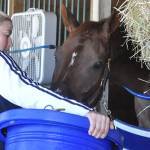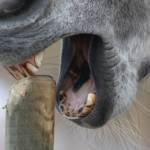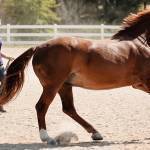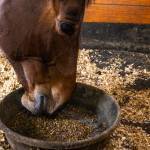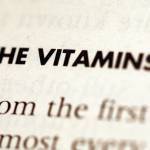Question
I recently had my 16-year-old Paint mare tested for polysaccharide storage myopathy (PSSM) and found out she carries mutant alleles for PSSM type 2 (PSSM2). She has also been tested for glycogen branching enzyme deficiency (GREB) and is n/GBED. Is there a link between the two diseases? She is very irritable and uncomfortable under saddle. I suspect muscle-related tightness is causing these issues. Would the diet for this mare be different than a PSSM type1 horse? I am currently feeding a low-starch feed at 3 lb (1.4 kg)/day with 1 lb (0.45 kg) of a balancer pellet. She gets free-choice Bermudagrass hay, and I am wondering if adding alfalfa would be a good addition?
Answer
I am not aware of a link between PSSM and GBED other than both diseases can occur in Quarter Horses and related breeds. The results of the genetic testing are important if you decide to breed your mare, as thoughtful breeding choices should be made to avoid perpetuation of heritable diseases.
The test results combined with the symptoms you explained lead me to believe your mare may benefit from following PSSM2 dietary recommendations. However, it is important to note that exercise intolerance without high serum CK activity could be a sign of another type of lameness. If possible, rule out other causes of lameness by having an in-depth soundness examination performed by a veterinarian.
The diet recommendations for PSSM2 are not very different from the reduced starch and sugar diets for PSSM1 horses. Horses with PSSM2 benefit from a diet that is slightly higher in protein. Providing alfalfa as a protein-rich forage would be an advantageous addition to the free-choice grass hay, and a supplemental source of amino acids such as lysine, methionine, and threonine might be beneficial.
Your mare consumes less than the manufacturer’s recommended intake of feed, so the balancer pellet is meeting her nutrient requirements successfully. A gradual introduction of fat as a “cool” energy source may also help. A stabilized rice bran product that also contains amino acids would be an excellent option.
Antioxidant support can be beneficial to help reduce oxidative stress and damage. Vitamin E is an important antioxidant involved in neuromuscular function, and research has shown horses with muscle disorders can respond positively to daily supplementation. Additional antioxidant support with coenzyme Q10 is another way to support muscle health and recovery. Coenzyme Q10 is involved in aerobic energy generation and also works to reduce oxidative damage. Choose high-quality antioxidants that feature superior bioavailability.
The last thing to address is electrolyte balance and replenishment. Horses exercising in hot climates should have daily electrolyte supplementation to replenish the losses that salt alone cannot replace. In selecting an electrolyte, choose one formulated by a reputable manufacturer. Research-formulated electrolytes are chock-full of minerals, like sodium, chloride, potassium, and magnesium.


